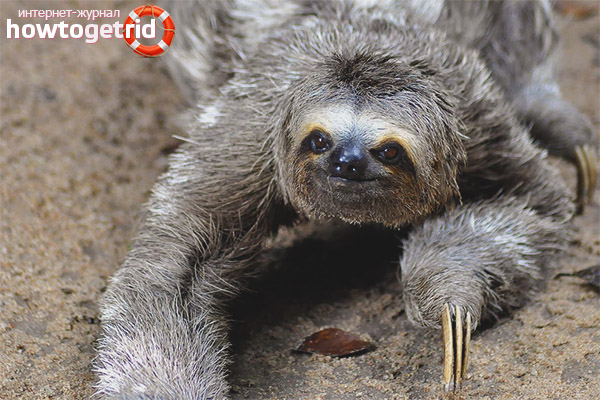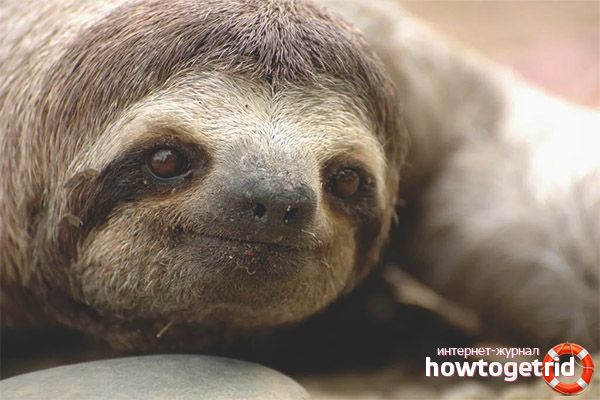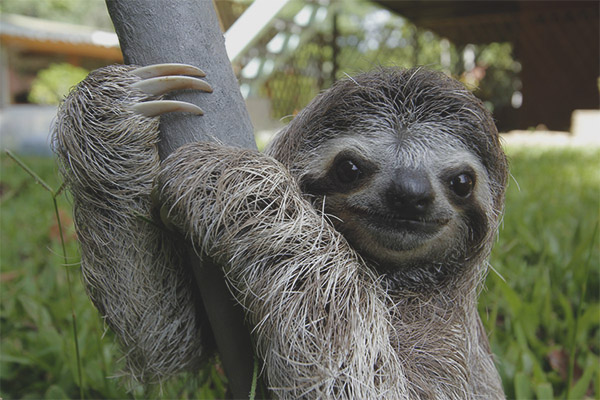The content of the article
All over the world life is in full swing. People are bustling around, trying to create comfortable conditions around themselves, overcoming a lot of difficulties, and animals in search of food and better conditions are ready to cope with any difficulties, fight enemies, actively defending their territory. And only sloths philosophically deny all this fuss, probably finding it strange and useless. Their life is slow and orderly in a slow rhythm on the branches of the trees, the leaves of which they feed. So that nothing breaks such a rhythm, nature has foreseen everything: the special structure of the internal organs, and the external adaptations of the animal.
Perhaps one of the first to describe this beast was Charles Darwin, comparing the remains of a huge, larger than elephant, megatheria found in South America. This beast, as it turned out during the study, was mammal and not full-toothed.A medium-sized sloth has exactly the same structure of the spine and skull, its children also feed on breast milk, and their teeth also do not have enamel coating, and do not have a complex structure.
For the classification of the sloth, they identified the American half-toothed in the class, and along with it turned out a number of armadillos, anteaters, and others, differing in this structure of the teeth. Although outwardly, they are significantly different from each other.
Appearance
It is very easy to distinguish a small sloth, who peacefully slumbers on a branch, from other animals. The diversity of this family is not different, there are only five species, which are divided into sloths of three and two fingers.
These are small animals, having a height of 50 to 60 cm. And their weight is quite small - from 4 to 6 kg. Looking at the appearance, it is possible to decide that it is a monkey, however, this is a very big mistake, although there are some common signs in their physiques.
The muzzle is very overgrown with thick and long hair, so the black eyes that look like small buttons look very clearly, just like the black nose. The ears are very small.The sloth has such mimic muscles that it seems that he is constantly in a good mood, and the smile does not leave his cute, good-natured little face. But, by the way, when food is nearby, and the enemies are far away, is this not a reason for a benevolent attitude.
There are 8 to 9 cervical vertebrae in the neck, and this is their advantage over other mammals that have fewer of them, and even the giraffe has no more than 7. Due to this number, the sloth can observe the space by turning its head 180 degrees.
The tail is very small, it is not easy to distinguish it under a thick layer of wool. The distinguishing feature of this animal is fingers. They are oblong and accreted along the entire length, at the end they resemble long curved hooks, and it is thanks to them that the sloth deftly hangs even on the most curved branch, moves along the ground. But animals can not make various jumps and freely swing on the branches.
Their coat is shaggy, long and thick, with a brown-gray color.
Since this animal does not make active movements, its metabolic processes are inhibited, and the body temperature does not rise above 33 degrees.And sometimes it can fall to 24 degrees, and the animal will feel great at the same time.
Internal organs do not cease to attract the attention of scientists, as they are truly unique in everything. The teeth of the roots do not have enamel coating is also not observed. All teeth are equal, and each performs the same function, there is no difference between them. Only in two-fingered can be found isolated fangs. Of all the senses, only the sense of smell is developed perfectly, and the rest of nature was not generous. Therefore, sight, hearing in sloths do not have good qualities.
From the peculiar way of life, the insides of the animal have undergone great changes, and now the liver is separated from the abdominal wall by the stomach and is almost at the back. The stomach and intestines are very large. And it is not surprising, because the weight of an animal consists almost half of digestible vegetation, and the intestines are cleaned once a week or much less. The bladder is also large, and so much so that it reaches the diaphragm. And this is also not surprising, because the sloth has to descend on the ground to empty the bladder, and this action takes place once every few days.
The spleen eventually moved to the right, and the trachea arched. All these movements are due to the fact that the animal prefers to often hang back down.
Where sloths live

The natural conditions of Central and South America are most favorable for these shaggy animals. Less often you can meet them in Honduras or in the northern part of Argentina. In the most often warm equatorial or tropical forest, they settle where there is a wide crown with a lot of tasty food, preferring only a woody lifestyle. To move in limbo, clasping the branch with its claws-hooks and hanging upside down, and strong muscles allow you to hold the entire body weight. But many researchers argue that the muscle mass is not so strongly developed, the sloth hangs solely thanks to its claws.
Sloths can also find shelter in the mountains, if there are, of course, thick trees, at an altitude of 1,100 m.
Sloths sometimes have to leave a tree. When it is time to empty the bladder and intestines, they are forced to descend to the soil, often overcoming a distance down more than 30 - 40 m.This journey takes a long time, but rarely happens, since food is processed in the gastrointestinal tract for a long time - almost a week. In the intestines live special bacteria that help digest such complex solid plant foods.
Before starting the process of defecation, they must dig a small hole, and then carefully scoop up the toilet.
Animals move along the ground too slowly, on the stomach. They throw the paw forward, and then pull up to it. In this case, they are very helpful claws.
But then these animals swim fast - more than 3-4 km / h. Especially these qualities are useful when water in certain seasonal periods, in the flood, floods the earth and does not leave for several months. Swimming helps in this: in the water contains algae, which are entangled in wool and give it an emerald hue. This color can then play a saving role when you need to hide from a predator.
And the dangers of these benevolent animals quite a lot. Their meat is tasty, so people hunt for them. Going down, the sloth can get caught by a jaguar or puma.These wild ferocious cats can also hunt on the lower branches of trees, because the sloth tries to keep as high as possible, where the branches are thinner. However, there can happen misfortune. Harpies - birds of prey and powerful - can remove a small animal from a branch without making special efforts. In water, they can be eaten by a crocodile.
But, when danger lurks, the sloth manifests itself as an active fighter, setting in motion its powerful claws. Due to good survivability, excellent immunity, very slow metabolic processes, unhurried blood flow, these animals suffer not so painful injuries.
Forest dweller lifestyle

Sloth is very difficult to see in the forest. Not only does he live on a high tree, but he does not move much, his coat color is barely noticeable, his breathing is quiet. The movements of the animal are never sharp, it is possible that they will start jumping and swaying on the branches. They can move in just a few meters per minute.
They prefer to live alone, but if suddenly two individuals are together on the same branch, then quarrels over sharing the territory never happen.This neighborhood is quite peaceful, and they even sleep nearby. And sleep is usually very long - at least 10 hours.
Moth moths find shelter in their thick wool, using such shelter as a safe shelter.
The sloth eats foliage and fruits of trees, without migrating anywhere. If suddenly a butterfly, insects or a lizard are very close, they will be eaten right away. The basis of nutrition is eucalyptus leaves. While the animal is not sleeping, it almost constantly eats, because such food does not contain a lot of calories, and saturation will come only after a large number of leaves eaten. In addition, the sloth's teeth are constantly growing, because they have to constantly grind. To quench their thirst, these animals lick the dew from the surface of the leaves. However, moisture is mainly found in juicy tropical fruits and leaves, and this wave is sufficient for the body.
Due to the fact that this tree resident most often likes to be in limbo, his paws are occupied, and he produces food with the help of his lips and teeth.
All food is digested very slowly, and this process continues for a month. Therefore, defecation occurs not as often as in other animals, but from one to three times a month.
Procreation

The sloth in principle suits everything, but if he is dissatisfied with something, he can sniff or make plaintive sounds. But when you want to attract a female or male, here any sloth is trying with might and main, because only this way you can find a partner for marriage games. For three-toed individuals, the time for this is in the spring, and for the two-toed ones, the mating season is extended for the whole year. These animals never fight among themselves for the chosen one.
After the female has become pregnant, the male leaves her, and in the future it is the mother’s concern - to carry the baby, feed it and raise it.
The first few months, except for breast milk, the baby does not receive any complementary foods. Then the mother allows him to eat the leaves in small quantities, so that the body absorbs solid food. In this childhood period, sloths are quite active. Mother sloth is very sensitive and caring, trying to pass on to the child all his knowledge of survival.
Already at 9 months of age, an older child is ready for independent living. But it is believed that a fully mature sloth can become 2.5 years old. Usually females leave mother earlier, starting an independent life.
If conditions are favorable, these animals can live up to 40 years.
Video: Sloth (Bradypodidae)











To send